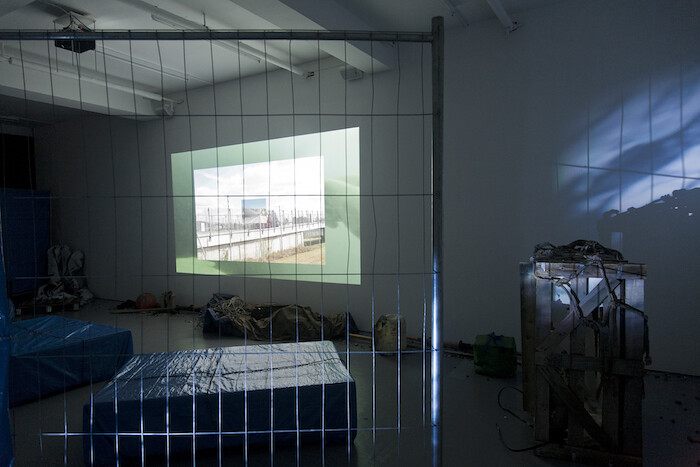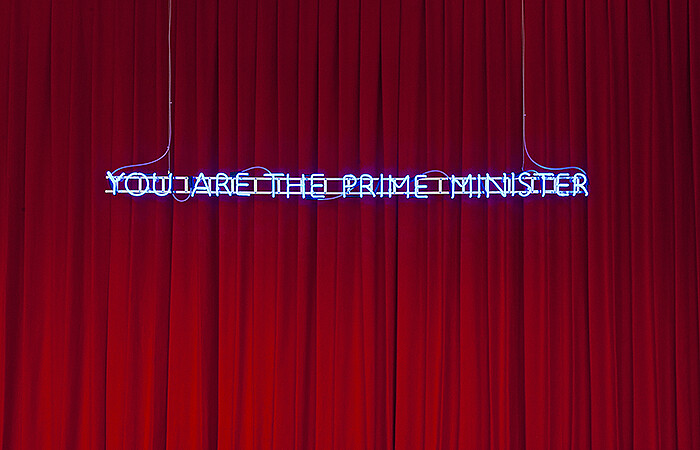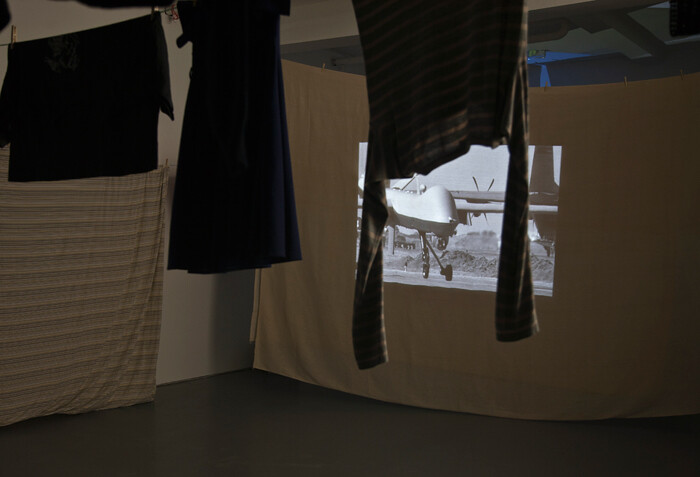Categories
Subjects
Authors
Artists
Venues
Locations
Calendar
Filter
Done
December 10, 2015 – Review
George Barber’s “Fences Make Senses”
Marina Vishmidt

You could imagine it happening in a George Barber video. Nothing for a while, then three come along at once—you can almost hear the folksy, mordant voiceover that features in so many of them. Like the cars filmed from above driving an abstract expressionist tableau into being in Automotive Action Painting (2006), three Barber solo shows sketching the arc of the veteran video artist’s production opened across two continents in the autumn of 2015. Two retrospectives and a new commission are on view in Cardiff and Los Angeles, while Hoxton’s waterside contemporary—a long-term production partner for the artist—hosts two of Barber’s recent pieces, Fences Make Senses (2014) and Basement Pool (2015).
Barber’s maverick trajectory as a moving-image artist took him, until fairly recently, on a detour around the gallery exhibition circuit. This is not untypical of a generation of video artists, particularly in Britain, whose participation in the art world was rendered optional by the equally prominent critical and productive complexes of festivals, video distributors, and television platforms. He saw his mission as “structuralism plus fun,” insisting on engaging the audience rather than torturing them with duration—evidence of the love/hate relationship with the structuralist film milieu that molded him. Barber’s exuberant, …
June 27, 2014 – Review
Karen Mirza and Brad Butler’s “The Unreliable Narrator”
Morgan Quaintance

Hung against a backdrop of deep-red curtains the statement, “YOU ARE THE PRIME MINISTER,” glows in electric blue neon. Even in daylight its artificial, storefront brightness beams through waterside contemporary’s windows and is legible far beyond them into the large social housing complex surrounding the gallery.
Although it is clearly visible, London-based artists Karen Mirza and Brad Butler’s arch signage is largely ignored. The image of everyday disinterest this presents—people passing by unawares and inattentive—serves as an apt visual simile for what the British public’s relationship to party politics is currently like. Detached and disengaged, voters across the United Kingdom feel anything but empowered by a prime minister elected to embody and enact their individual wills. Aside from the fact that nobody voted for the current coalition government, politicians have demonstrated they are only in it for themselves through lies about weapons of mass destruction in Iraq, blatant policy U-turns, cross-party corruption scandals, tax breaks for the rich, and the bludgeon of perpetual austerity measures for the working and middle classes. Put simply, in a society that still turns on hereditary privilege, politics is seen as a tool created for, and operated in the service of, moneyed elites. The psychological and …
March 4, 2013 – Review
George Barber’s “The Freestone Drone”
Omar Kholeif

George Barber, the pioneering British video artist influential in defining the Scratch Video movement, launched his first solo show at Waterside Contemporary with “The Freestone Drone”—an installation that resembled a domestic yard-cum-war zone. As one entered, strung up across the gallery walls were numerous washing lines, covered with sheaths of clothing, creating a soft and comforting architecture, which was quickly punctured by the piercing noise of Unmanned Aerial Vehicles (UAVs) in the periphery. UAVs, more commonly known as drones, have become synonymous with modern warfare, replacing human air fighters in small-scale or covert combat situations.
The current U.S. administration has reportedly been responsible for increasing deployments of drones to Afghanistan, Pakistan, and Yemen to the tune of tens of thousands of aircraft, a six-fold increase to what it was under Bush. Accordingly, the drone has also become a phenomenon that occupies a number of contemporary artists. James Bridle’s Drone Shadow 002 (2012) and Dronestagram are two projects that consider the cultural impact of drones across different media. The former seeks to make visible the shadows of drones by publically marking out physical representations of these UAVs on public floors and spaces, while the latter uses social media to highlight …
